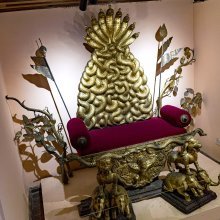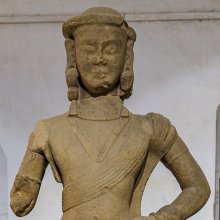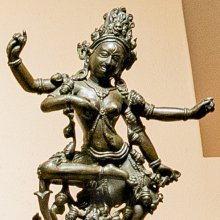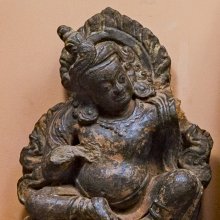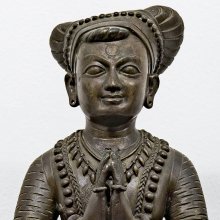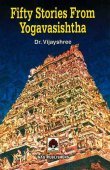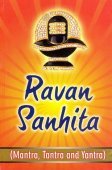King: 7 definitions
Introduction:
King means something in Buddhism, Pali, Hinduism, Sanskrit, Jainism, Prakrit, the history of ancient India. If you want to know the exact meaning, history, etymology or English translation of this term then check out the descriptions on this page. Add your comment or reference to a book if you want to contribute to this summary article.
Images (photo gallery)
(+212 more images available)
In Hinduism
Natyashastra (theatrics and dramaturgy)
Source: Shodhganga: Elements of Art and Architecture in the Trtiyakhanda of the Visnudharmottarapurana (natya)1) Kings (in Indian dramas) should be presented as “firm, brave and sportive”, as dictated by the Dhīroddhata classification of Heroes (nāyaka), according to the Viṣṇudharmottarapurāṇa, an ancient Sanskrit text which (being encyclopedic in nature) deals with a variety of cultural topics such as arts, architecture, music, grammar and astronomy.—In the Viṣṇudharmottarapurāṇa, it is narrated that Kings should be dhīralalita i.e., firm, brave and sportive.
2) Kings and various other characters (in Indian Dramas) were commonly mustached and bearded, as conveyed through the Aṅgaracanā division of Āhāryābhinaya: one of the four divisions of Abhinaya or “ways to convey or represent one’s emotion to others”, according to the Nāṭyaśāstra and the Viṣṇudharmottarapurāṇa.—The Nāṭyaśāstra says that after painting the face and other limbs the characters are provided with beard according to their territory, profession and spiritual rites. According to Viṣṇudharmottarapurāṇa, the kings, ascetics, ministers, priests, judges, lovers etc. should be mustached and bearded and the colour of their beard should be white except those of the kings and lovers. All these are the important points in a theatrical performance to project the concerned character in a clear and conspicuous way.

Natyashastra (नाट्यशास्त्र, nāṭyaśāstra) refers to both the ancient Indian tradition (shastra) of performing arts, (natya—theatrics, drama, dance, music), as well as the name of a Sanskrit work dealing with these subjects. It also teaches the rules for composing Dramatic plays (nataka), construction and performance of Theater, and Poetic works (kavya).
Yoga (school of philosophy)
Source: ORA: Amanaska (king of all yogas): A Critical Edition and Annotated Translation by Jason BirchThe King (of all Yogas) is denoted by the Sanskrit term Rāja-Yoga, according to the Amanaska Yoga treatise dealing with meditation, absorption, yogic powers and liberation.—Accordingly, as Īśvara says to Vāmadeva: “The preliminary [Yoga] is furnished with external Mudrās and [thus,] it is regarded as an external Yoga. [Whereas] the other [Yoga] is richly endowed with an internal Mudrā [and] for that reason, it alone is the internal Yoga. The [internal yoga] is called Rājayoga. O chief of sages, it alone is known as Rājayoga because it is the king of all Yogas (rājayoga). [...]”.

Yoga is originally considered a branch of Hindu philosophy (astika), but both ancient and modern Yoga combine the physical, mental and spiritual. Yoga teaches various physical techniques also known as āsanas (postures), used for various purposes (eg., meditation, contemplation, relaxation).
In Buddhism
Mahayana (major branch of Buddhism)
Source: Brill: Śaivism and the Tantric Traditions (mahayana)The King (in Sanskrit: Rāja, or Manuṣyarāja) is mentioned in the sixth chapter of the Suvarṇaprabhāsottamasūtra, a Buddhist Mahāyāna Sūtra which teaches the protection of the state for the mutual benefit of the Buddhist Sangha and the monarch.—Accordingly, Chapter six (caturmahārājaparivarta—“on the four great kings”), conveys an explicit message: those kings (manuṣya-rāja) who venerate the Suvarṇaprabhāsottama and support the Buddhist Sangha will be protected from hostile armies and other dangers by the Four Great Kings (caturmahā-rāja), and their countries will exist in highest state of harmony. Simultaneously, those who ignore this tradition will face decline. This Sūtra directly and repeatedly refers to monarchs, and throughout this chapter and the whole scripture it is obvious that kings are envisaged as the principal target audience. At one point the scripture calls itself a rāja-śāstra, a text for kings.

Mahayana (महायान, mahāyāna) is a major branch of Buddhism focusing on the path of a Bodhisattva (spiritual aspirants/ enlightened beings). Extant literature is vast and primarely composed in the Sanskrit language. There are many sūtras of which some of the earliest are the various Prajñāpāramitā sūtras.
Tibetan Buddhism (Vajrayana or tantric Buddhism)
Source: ORA: Amanaska (king of all yogas): (Tibetan Buddhism)Kings (in Sanskrit: Rājāna) can be attracted/subdued by one having the Siddhi (power) of Speech, according to verse 14.24bd-27 of the Laghuśaṃvara, an ancient Buddhist Yoginī Tantra.—Accordingly: “The Sādhaka [who has] the Siddhi of speech can certainly attract a king (rājāna) or queen by [merely] thinking [it]. He quickly controls gods, demons and men. When angry, he can kill with his speech and drive away his adversary. The practitioner can thus effect a curse with his speech [...]”.

Tibetan Buddhism includes schools such as Nyingma, Kadampa, Kagyu and Gelug. Their primary canon of literature is divided in two broad categories: The Kangyur, which consists of Buddha’s words, and the Tengyur, which includes commentaries from various sources. Esotericism and tantra techniques (vajrayāna) are collected indepently.
In Jainism
General definition (in Jainism)
Source: archive.org: TrisastisalakapurusacaritraThe King represents the “punisher of those transgressing boundaries”, according to chapter 1.2 [ādīśvara-caritra] of Hemacandra’s 11th century Triṣaṣṭiśalākāpuruṣacaritra: an ancient Sanskrit epic poem narrating the history and legends of sixty-three illustrious persons in Jainism.—Accordingly, “[...] together the twins approached Ṛṣabhanātha, and told him all the sin that was being committed. Possessing the three kinds of knowledge, recalling (former) births, the Master said, ‘A king will be the punisher of those transgressing boundaries. Seated on a very high throne, consecrated first, having at hand the fourfold army, he should have unbroken commands’. They said, ‘Be our king. Why do you neglect us? No one else like you is seen among us’ [...]”.

Jainism is an Indian religion of Dharma whose doctrine revolves around harmlessness (ahimsa) towards every living being. The two major branches (Digambara and Svetambara) of Jainism stimulate self-control (or, shramana, ‘self-reliance’) and spiritual development through a path of peace for the soul to progess to the ultimate goal.
India history and geography
Source: Shodhganga: Vernacular architecture of Assam with special reference to Brahmaputra ValleyKing is a Tai Khamti term referring to “3-legged hearth”.—It appears in the study dealing with the vernacular architecture (local building construction) of Assam whose rich tradition is backed by the numerous communities and traditional cultures.
Source: Singhi Jain Series: Ratnaprabha-suri’s Kuvalayamala-katha (history)Kings were commonly depicted on the Saṃsāracakra paintings (representing scenes of human life), in ancient India, as mentioned in the Kathās (narrative poems) such as Uddyotanasūri in his 8th-century Kuvalayamālā (a Prakrit Campū, similar to Kāvya poetry).—Page 185.21 f.: Here follows a description of a printed scroll illustrating the Jaina conception of saṃsāracakra. [...] The saṃsāra-cakra illustrated the three worlds of hell, human world and the world of gods. [For example:] A king seated on his throne and surrounded by his feudatories and feeding on five mouthfuls of food offered in a leafy cup by a woman.

The history of India traces the identification of countries, villages, towns and other regions of India, as well as mythology, zoology, royal dynasties, rulers, tribes, local festivities and traditions and regional languages. Ancient India enjoyed religious freedom and encourages the path of Dharma, a concept common to Buddhism, Hinduism, and Jainism.
See also (Relevant definitions)
Starts with (+26): Kimgahana, Kimgini, Kimgirida, King begonia, King Bimblisara, King desertparsley, King fern, King island melilot, King of bitters, King of the forest, King of the timber, King silk cotton tree, King-of-the-meadow, Kingan, Kingari, Kingbou, Kingcup, Kingcup cactus, Kingcups, Kingela.
Ends with (+16): Analytical thought, Asking, Attacking, Beyond waking, Blinking, Blok king, Boking-boking, Celangking, Cooking, Dangdangking, Dieng-latyrking, Discursive Thinking, Drinking, Intentional thinking, Jungle king, Love-making, Parking, Peking, Picking, Plucking.
Full-text (+16994): Rajadhiraja, Rajan, Rajaraja, Nripa, Rajendra, Narapati, Maharaja, Mahipala, Sagara, Abhisheka, Nagaraja, Indra, Bhoja, Raja, Vasuki, Bhupa, Ikshvaku, Udayana, Rajaka, Naradeva.
Relevant text
Search found 437 books and stories containing King; (plurals include: Kings). You can also click to the full overview containing English textual excerpts. Below are direct links for the most relevant articles:
Jarasandhavadha Mahakavyam (by Pankaj L. Jani)
Canto 13 - The Brahmin Reaches Dvarika
Canto 12 - The Faith of Imprisoned Kings in Lord Krishna
Part 4 - Story of the Jarasandhavadha Mahakavyam < [Critical Introduction]
Vakyapadiya of Bhartrihari (by K. A. Subramania Iyer)
Verse 3.14.553 < [Book 3 - Pada-kāṇḍa (14): Vṛtti-samuddeśa (On Ccomplex Formation)]
Verse 3.14.554 < [Book 3 - Pada-kāṇḍa (14): Vṛtti-samuddeśa (On Ccomplex Formation)]
Verse 3.14.557 < [Book 3 - Pada-kāṇḍa (14): Vṛtti-samuddeśa (On Ccomplex Formation)]
Harivamsha Purana (by Manmatha Nath Dutt)
Chapter 53 - Jarasandha’s Proposal to Invite Kalayavana < [Book 2 - Vishnu Parva]
Chapter 51 - Kaishika Worships Krishna < [Book 2 - Vishnu Parva]
Chapter 54 - Shalya Meets Kalayavana < [Book 2 - Vishnu Parva]
Blue Annals (deb-ther sngon-po) (by George N. Roerich)
Chapter 2 - The genealogy of Mahāsammata < [Book 1 - The beginning of the story of the Doctrine]
Chapter 9 - The Tibetan emperors prophesied in the Mūlatantra < [Book 1 - The beginning of the story of the Doctrine]
Chapter 7 - Tibetan imperial lines < [Book 1 - The beginning of the story of the Doctrine]
Heimskringla (by Snorri Sturlson)
Part 40 - The Burning In Upsal < [Chapter I - The Ynglinga Saga]
Part 74 - Mutilating Of The Upland Kings < [Chapter VII - Saga Of Olaf Haraldson]
Part 97 - Meeting Of Reconciliation Between The Kings < [Chapter VII - Saga Of Olaf Haraldson]
The Devi Bhagavata Purana (by Swami Vijñanananda)
Related products
(+17 more products available)
